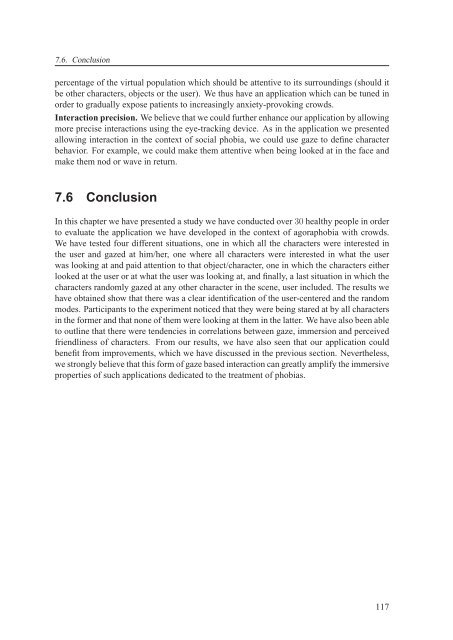Texte intégral / Full text (pdf, 20 MiB) - Infoscience - EPFL
Texte intégral / Full text (pdf, 20 MiB) - Infoscience - EPFL
Texte intégral / Full text (pdf, 20 MiB) - Infoscience - EPFL
Create successful ePaper yourself
Turn your PDF publications into a flip-book with our unique Google optimized e-Paper software.
7.6. Conclusion<br />
percentage of the virtual population which should be attentive to its surroundings (should it<br />
be other characters, objects or the user). We thus have an application which can be tuned in<br />
order to gradually expose patients to increasingly anxiety-provoking crowds.<br />
Interaction precision. We believe that we could further enhance our application by allowing<br />
more precise interactions using the eye-tracking device. As in the application we presented<br />
allowing interaction in the con<strong>text</strong> of social phobia, we could use gaze to define character<br />
behavior. For example, we could make them attentive when being looked at in the face and<br />
make them nod or wave in return.<br />
7.6 Conclusion<br />
In this chapter we have presented a study we have conducted over 30 healthy people in order<br />
to evaluate the application we have developed in the con<strong>text</strong> of agoraphobia with crowds.<br />
We have tested four different situations, one in which all the characters were interested in<br />
the user and gazed at him/her, one where all characters were interested in what the user<br />
was looking at and paid attention to that object/character, one in which the characters either<br />
looked at the user or at what the user was looking at, and finally, a last situation in which the<br />
characters randomly gazed at any other character in the scene, user included. The results we<br />
have obtained show that there was a clear identification of the user-centered and the random<br />
modes. Participants to the experiment noticed that they were being stared at by all characters<br />
in the former and that none of them were looking at them in the latter. We have also been able<br />
to outline that there were tendencies in correlations between gaze, immersion and perceived<br />
friendliness of characters. From our results, we have also seen that our application could<br />
benefit from improvements, which we have discussed in the previous section. Nevertheless,<br />
we strongly believe that this form of gaze based interaction can greatly amplify the immersive<br />
properties of such applications dedicated to the treatment of phobias.<br />
117

















